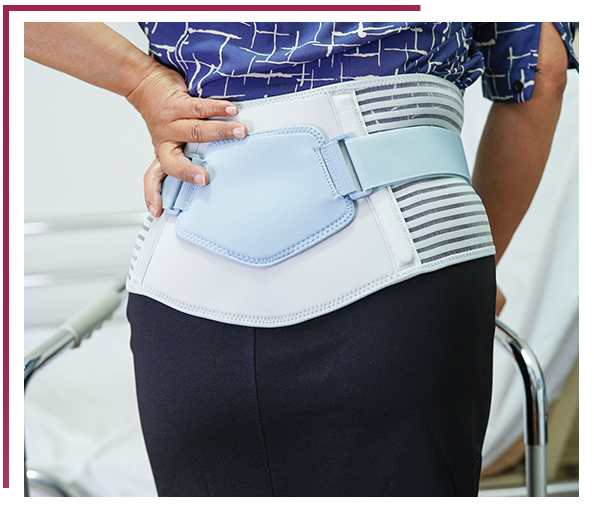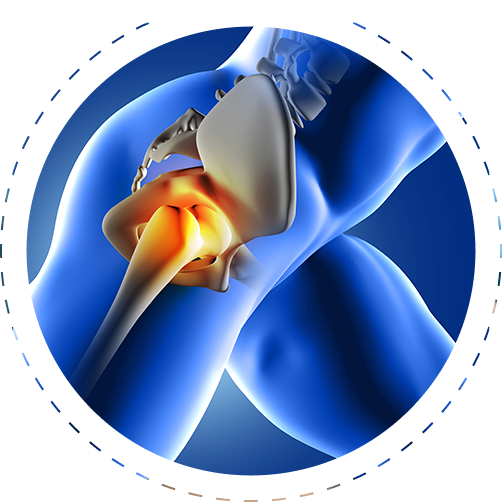Hip Replacement Surgery in Ahmedabad
Dr. Saurin Shah’s Expertise

Hip replacement surgical procedure
Hip replacement is a surgical procedure in which the hip joint replaced by a prosthetic implant. They can perform it as a total replacement or a Hemi (half) replacement. This surgery relieves arthritis pain or fixes the severe physical joint damage as part of hip fracture treatment.
A total hip replacement (total hip arthroplasty) comprises replacing both the acetabulum and the femoral head while hemiarthroplasty only replaces the femoral head.
Hip replacement is a successful and reliable orthopedic operation. The improved outcome is 97%.

What is Hip Replacement?
Hip replacement is a surgical procedure to replace a damaged hip joint with an artificial implant. It relieves pain, restores the quality of life and improves joint function for patients with severe arthritis or injury.
Hip Replacement Implants
-
We use DePuy (J & J), Exactech (USA), Zimmer implants.
-
Sometimes we use Indigenous implants.

Common Causes of Hip Pain
- Osteoarthritis – Wear-and-tear damage to the joint
- Rheumatoid Arthritis – Autoimmune inflammation of the joint
- Avascular Necrosis – Loss of blood supply to the hip bone
- Hip Fractures – Due to injury or osteoporosis
- Congenital Disorders – Developmental hip abnormalities

When is Total Hip Replacement Advised?
Dr. Saurin Shah may recommend hip replacement if:
-
Pain limits daily activities such as walking or climbing stairs
-
Medications and physiotherapy no longer provide relief
-
Stiffness reduces hip movement
-
Pain persists even at rest

Why it’s done?

Osteoarthritis:
Commonly known as wear-and-tear arthritis, osteoarthritis damages the slick cartilage that covers the ends of bones and helps joints move smoothly.
Rheumatoid arthritis:
Caused by an overactive immune system, rheumatoid arthritis produces an inflammation that can erode cartilage and occasionally underlying bone, resulting in damaged and deformed joints.
Osteonecrosis:
If there is inadequate blood supply to the ball portion of the hip joint, the bone may collapse and deform. You might consider hip replacement if you’re experiencing hip pain that:
- Persists, despite pain medication
- Worsens with walking, even with a cane or walker
- Interferes with your sleep
- Affects your ability to go up or down stairs
- Makes it difficult to rise from a seated position
What is Acetabular?
The Acetabular cup is the component it places into the acetabulum (hip socket). it attaches which using friction or cement.
Some acetabular cups are one piece, others are modular. One piece (monobloc) shells are polyethylene or metal. They have their articular surface machined on the inside surface of the cup and do not rely on a locking mechanism to hold a liner in place.
A monobloc polyethylene cup is cemented in place while it holds a metal cup in place by a metal coating on the outside of the cup.
Modular cups comprise two pieces, a shell, and liner. It makes the shell of metal; the outside has a porous coating while the inside contains a locking mechanism designed to accept a liner.

What is Femoral Component?
The femoral component is the component that fits in the femur (thigh bone).
There are two types of fixation, cemented and uncemented.
Cemented Stems:
They use acrylic bone cement to form a mantle between the stem and to the bone.
Uncemented Stems:
They use friction, shape and surface coatings to stimulate bone to remodel and bone to the implant.
It makes stems of multiple materials, titanium, cobalt chromium, and stainless steel and they can be monolithic or modular.
Modular components comprise different head dimension and/or modular neck orientations, these attach via a Morse taper. These options allow for variability in leg length, offset and version. It makes femoral heads of metal or ceramic.
It machines metal heads, made of cobalt chromium for hardness to size and then polished to reduce their coefficient of friction and minimize the wear they generate.
Ceramics heads have a lower coefficient of friction than cobalt chrome however they are more brittle.
Articular Interface
The particular interface is not part of either implant, rather it is the area between the acetabular cup and femoral component.
Articular Interface: Material
The particular interface of the hip is a simple ball and socket joint. Size, it can select material properties and machining tolerances at the articular interface based on patient demand to optimize implant function and longevity while mitigating associated risks.
The interface size measured by the outside diameter the head or the inside diameter of the socket.
Different combinations of material have different physical properties it can couple which reduce the amount of wear debris generated by friction.

NOTE: THIS MATERIAL DOES NOT CONSTITUTE MEDICAL ADVICE. IT IS INTENDED FOR INFORMATIONAL PURPOSES ONLY. PLEASE CONSULT A PHYSICIAN FOR SPECIFIC TREATMENT RECOMMENDATIONS.
Why Hip Replacement Surgery is Important
- Eliminates chronic pain
- Restores joint function
- Prevents further joint damage
- Improves mobility and independence
- Provides a long-term solution with implants lasting 20+ years

FAQ's
- 3–6 weeks for daily activities
- 3–6 months for full recovery
If pain persists despite medications, surgery is the best long-term solution.
Yes! Most patients are able to walk within 24 hours and regain near-normal mobility during recovery.




